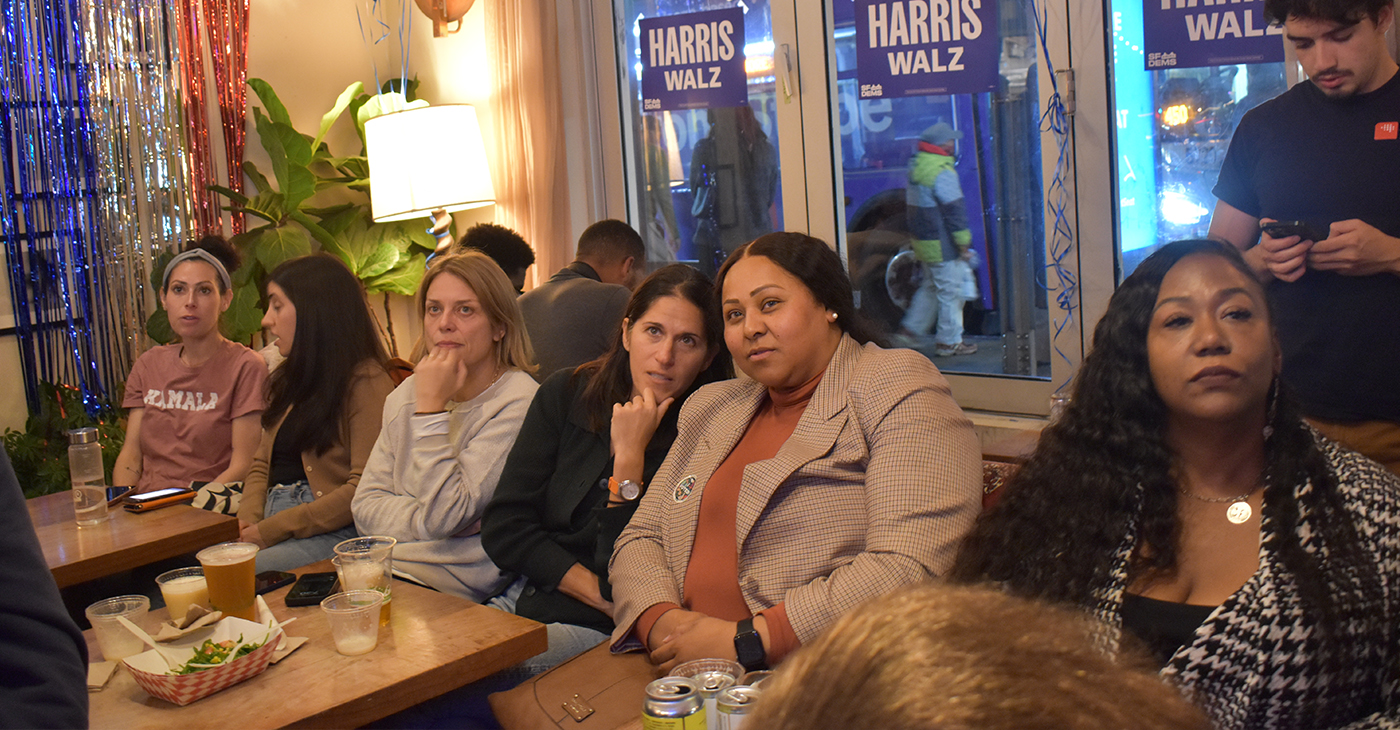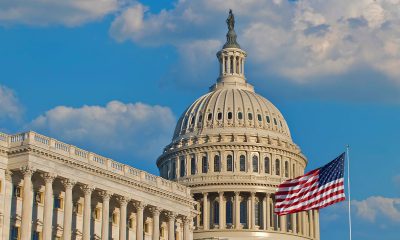Bay Area
Election Day Across the Bay: “Oh, Thank God, It’s Over!”, Anxious and Hopeful Voters Share Their Thoughts
Millions of people across the country stood in long lines and sat around their TVs waiting to see what the fate of the next four years would look like. In the Bay Area, college students, residents young and old, and hopeful voters shared feelings of excitement, but also a sense of dread.

By Magaly Muñoz
Millions of people across the country stood in long lines and sat around their TVs waiting to see what the fate of the next four years would look like.
In the Bay Area, college students, residents young and old, and hopeful voters shared feelings of excitement, but also a sense of dread.
The Post visited polling sites and election night parties to talk to voters about how they felt after a whirlwind election cycle.
These reactions were taken before the presidential race was called and Donald Trump was declared president-elect.
First Time Voters
At UC Berkeley, students piled into a cramped building, Eshleman Hall, to cast their votes in between classes.
Outside of the hall, the Associated Students of the University of California (ASUC) were handing out free pizza and “Go Bears. Go Vote” stickers to students who proved they submitted their ballot.
“We want to make sure that there are reduced barriers to entry for people who may be voting for the first time or challenge themselves to get to the polls. We want to make sure that people are rewarded for being civically engaged,” Carmen Berry, ASUC student, said.
Berry, who voted for Vice President Kamala Harris, said this was her first experience voting in a presidential election and she’s kept in mind all there is to lose, such as reproductive rights, should Donald Trump win.
“We need to vote for ourselves, and we need to vote for the America that we want to become,” Berry said.
Katie, a Business and Cognitive Science major, told the Post that being from California, a traditionally Democrat state, makes her feel like her vote doesn’t actually matter because she knows the results will sway Harris’ way regardless.
She’s also worried about reproductive rights, and the future of the Department of Education, a department Trump has vowed to end when in office.
“My brother is special needs. He’s on IEP and without the Department of Education, he would not have been able to graduate high school. So, for me, it’s definitely personal,” Katie said.
Long Lines at Oakland Public Library
At 6 p.m. on election night, the Oakland Public Library on 14th Street had a line of voters wrapped around half the building. People toward the front of the building said they had been waiting for nearly an hour to get inside and cast their votes.
Nakia White, an Oakland resident, said she voted against the recalls for Mayor Sheng Thao and Alameda District Attorney Pamela Price. She thinks the entire recall process has been a waste of time and money, though she acknowledges the recalls will likely succeed because of the big pockets backing them.
“I feel like the people who are funding [the recalls] are doing this so they can get someone in who will let them buy up all the property and raise property values, which means local residents will not be able to afford to live here, as we already can’t,” White said.
Mark A, a recent Oakland resident, said he voted for Harris because she fits more into the mold of the progressive policies he supports. Being Latino, he said that Trump’s negative rhetoric turned him off as a voter.
Mark said that if he had to choose one word to describe the current election cycle, it would be “chaotic”.
Election Parties Start to Show Loss of Hope
Fluid510, a bar lounge across the street from Oakland City Hall, started seeing trickles of voters in the early evening as they kicked off their election party.
The location was adorned with “Bay Area for Harris/Walz” signs and red, white, and blue decor. Patrons were giddy with excitement until voting results started piling in on the big screen around 7 p.m.
ReAnn Scott, a Berkeley resident, told the Post that watching the NBC coverage was starting to scare her. There was too much red, signifying the states where Trump was winning, on the screen.
But she’s enthusiastically said she’s glad the election cycle has ended. She’s tired of all the political messaging that’s been forced on people for months now.
“Oh, thank God, it’s over!” Scott said.
Over in San Francisco, Manny’s, a civic and political event space, hosted a block party with a huge screen outside on Valencia Street and a packed venue at their 16th Street location.
Speakers attempted to talk down the crowd as more votes started to skew toward a Trump win. Those in attendance had weary faces and conversations were starting to show doubt that Harris could pull through and win the presidential race.
“I’m just so pissed,” one patron said as the CNN electoral map filled with red state wins.
Alameda County
Seth Curry Makes Impressive Debut with the Golden State Warriors
Seth looked comfortable in his new uniform, seamlessly fitting into the Warriors’ offensive and defensive system. He finished the night with an impressive 14 points, becoming one of the team’s top scorers for the game. Seth’s points came in a variety of ways – floaters, spot-up three-pointers, mid-range jumpers, and a handful of aggressive drives that kept the Oklahoma City Thunder defense on its heels.

By Y’Anad Burrell
Tuesday night was anything but ordinary for fans in San Francisco as Seth Curry made his highly anticipated debut as a new member of the Golden State Warriors. Seth didn’t disappoint, delivering a performance that not only showcased his scoring ability but also demonstrated his added value to the team.
At 35, the 12-year NBA veteran on Monday signed a contract to play with the Warriors for the rest of the season.
Seth looked comfortable in his new uniform, seamlessly fitting into the Warriors’ offensive and defensive system. He finished the night with an impressive 14 points, becoming one of the team’s top scorers for the game. Seth’s points came in a variety of ways – floaters, spot-up three-pointers, mid-range jumpers, and a handful of aggressive drives that kept the Oklahoma City Thunder defense on its heels.
One of the most memorable moments of the evening came before Seth even scored his first points. As he checked into the game, the Chase Center erupted into applause, with fans rising to their feet to give the newest Warrior a standing ovation.
The crowd’s reaction was a testament not only to Seth’s reputation as a sharpshooter but also to the excitement he brings to the Warriors. It was clear that fans quickly embraced Seth as one of their own, eager to see what he could bring to the team’s championship aspirations.
Warriors’ superstar Steph Curry – Seth’s brother – did not play due to an injury. One could only imagine what it would be like if the Curry brothers were on the court together. Magic in the making.
Seth’s debut proved to be a turning point for the Warriors. Not only did he contribute on the scoreboard, but he also brought a sense of confidence and composure to the floor.
While their loss last night, OKC 124 – GSW 112, Seth’s impact was a game-changer and there’s more yet to come. Beyond statistics, it was clear that Seth’s presence elevated the team’s performance, giving the Warriors a new force as they look to make a deep playoff run.
Activism
Oakland Post: Week of November 26 – December 2, 2025
The printed Weekly Edition of the Oakland Post: Week of November 26 – December 2, 2025

To enlarge your view of this issue, use the slider, magnifying glass icon or full page icon in the lower right corner of the browser window.
Activism
Oakland Post: Week of November 19 – 25, 2025
The printed Weekly Edition of the Oakland Post: Week of November 19 – 25, 2025

To enlarge your view of this issue, use the slider, magnifying glass icon or full page icon in the lower right corner of the browser window.
-

 Activism3 weeks ago
Activism3 weeks agoOakland Post: Week of November 12 – 18, 2025
-

 Activism4 weeks ago
Activism4 weeks agoOakland Post: Week of November 5 – 11, 2025
-

 Activism2 weeks ago
Activism2 weeks agoIN MEMORIAM: William ‘Bill’ Patterson, 94
-

 Activism3 weeks ago
Activism3 weeks agoHow Charles R. Drew University Navigated More Than $20 Million in Fed Cuts – Still Prioritizing Students and Community Health
-

 #NNPA BlackPress3 weeks ago
#NNPA BlackPress3 weeks agoThe Perfumed Hand of Hypocrisy: Trump Hosted Former Terror Suspect While America Condemns a Muslim Mayor
-

 Bay Area3 weeks ago
Bay Area3 weeks agoNo Justice in the Justice System
-

 #NNPA BlackPress3 weeks ago
#NNPA BlackPress3 weeks agoProtecting Pedophiles: The GOP’s Warped Crusade Against Its Own Lies
-

 #NNPA BlackPress2 weeks ago
#NNPA BlackPress2 weeks agoTrump’s Death Threat Rhetoric Sends Nation into Crisis























































